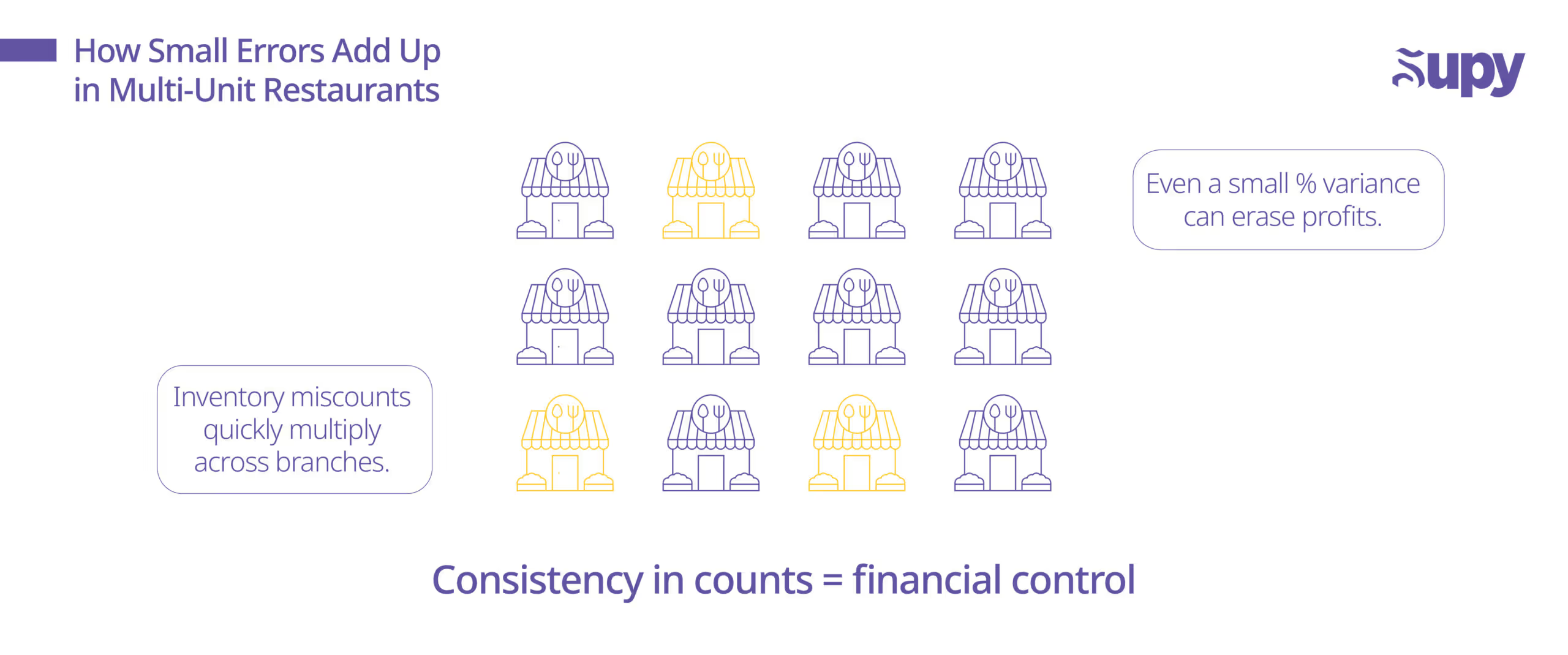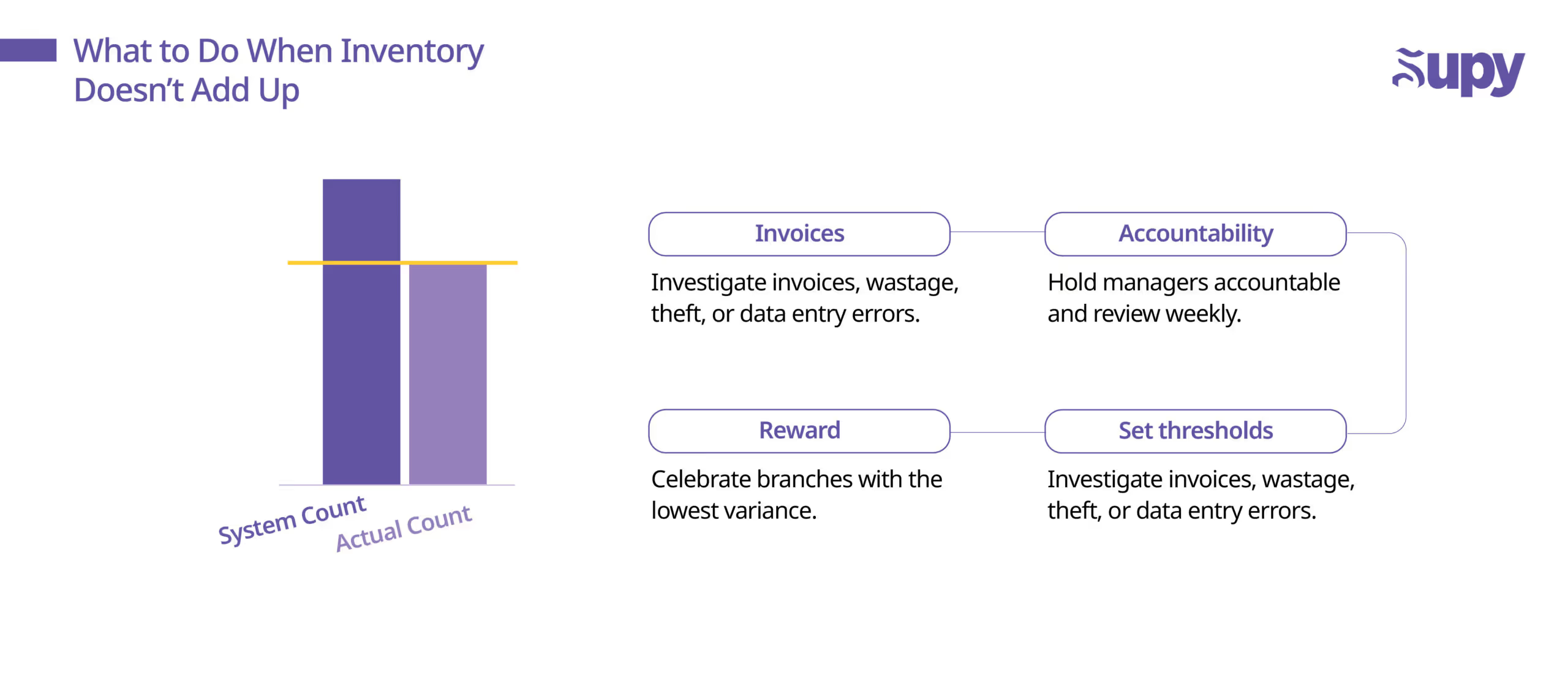Stock Counts 101: Ensuring Accurate Inventory in Every Restaurant Branch

Inventory counting – the dreaded stock take – is a task few restaurant managers enjoy, yet it’s absolutely critical for controlling food cost and preventing loss. For a multi-unit restaurant operator, inconsistent stock counts across branches can lead to big surprises on the balance sheet. If one location’s count is off by $1,000 and you have 20 locations, that could mean $20,000 in missing stock chain-wide, potentially erasing your profit margin. In fact, sloppy inventory practices and infrequent counts are a major reason many restaurants see higher food cost percentages than expected. To get a handle on your food and beverage costs, you need clean, accurate inventory data from every store.The good news? By applying a few best practices and using the right tools, you can make stock counts faster, easier, and far more accurate. This guide breaks down a Stock Count 101 playbook for operations directors and branch managers. From scheduling counts and standardizing procedures, to investigating variances and leveraging technology, these tips will help ensure that what’s on the books actually matches what’s on the shelves.

Establish a Regular Counting Schedule

The first step is to commit to a consistent counting schedule for each of your restaurant locations. Too often, restaurants only do a full inventory once a month (or less), which invites large errors to accumulate. Instead, implement a two-tier schedule: - Weekly cycle counts: Have each branch count a portion of their inventory every week – focusing on high-value, high-volume items. For example, one week counts all proteins and dairy, next week dry goods, etc. This rolling approach catches discrepancies early. - Monthly full counts: At the end of each month, do a comprehensive count of all stock at every location. This provides a clean slate for your financials and variance analysis.Reinforce this schedule as non-negotiable. The branch operations SOP specifically mandates weekly partial counts on key items and a full stock count every month. When senior leadership shows that inventory counts are a priority, local managers will treat them with the seriousness they deserve.
Standardize Your Count Procedures

If you have multiple people counting inventory across different stores, you need a standardized method so that “a count” means the same thing everywhere. Create a step-by-step count procedure (and checklist) that every branch follows. Key elements include: - Count at a consistent time: e.g. Sunday night after close, or first thing Monday morning, always before any new deliveries. This ensures similar conditions each count. - Prepare the environment: Organize storage areas, have count sheets or tablets ready, and prevent any receiving or usage during the count (you don’t want a chef pulling out 2 boxes of chicken mid-count). - Use the same units: Make sure all items are counted in their standard unit (kg, liters, each, etc.) across all branches to avoid confusion. - Two-person rule: Whenever possible, have one person count while another records, then double-check high-value items. This reduces miscounts and deters any temptation to fudge numbers.For efficiency, consider providing pre-printed count sheets or a mobile app that lists all items for that location. Arrange the list by storage area. As the Supy SOP suggests, assign each inventory item to a specific storage area in the system (freezer, dry storage, bar, etc.) – that way, counters can work through one section at a time and not overlook anything. By standardizing everything from timing to technique, you’ll get more reliable numbers.
Leverage Technology (Stop Counting with Pen and Paper)
If any of your branches are still doing pen-and-paper counts and later typing them into a spreadsheet, it’s time to modernize. Digital inventory counting tools can greatly improve accuracy and speed. Many inventory management systems (like Supy) offer mobile counting features: staff can walk the stockroom with a tablet or smartphone, enter counts directly into the system, and even scan barcodes for quick identification. This cuts down transcription errors (no illegible handwriting or typos to worry about) and instantly updates your central inventory records.Another advantage of using an inventory system is the ability to perform real-time variance checks. For instance, as soon as a count is submitted, the system can compare the counted quantity to the theoretical on-hand quantity and flag any large variance. One chain that switched to mobile inventory counting and live variance reporting saw their overall inventory discrepancy drop by 85% within a quarter (because issues were caught and fixed immediately rather than lingering for months). Technology can also save time – many operators report that digital counts take a fraction of the time of manual ones, freeing managers to focus on other tasks.Even if you don’t have fancy software, at least use spreadsheets with formulas to automate variance calculations. The goal is to have tools that highlight problems so you’re not flying blind. And remember to back up all count data centrally – a cloud-based system ensures that even if a manager leaves or a sheet gets lost, you have an audit trail of every inventory count.
Investigate Variances and Take Action

- A stock count is only as good as the follow-up it prompts. Variance is the difference between what your system says should be on hand versus what was actually counted. It essentially measures your inventory loss or gain (due to waste, theft, portioning error, etc.). Don’t file away the inventory report without scrutinizing these numbers: - Set a variance threshold (e.g. > $100 or > 2% of stock value) that triggers investigation. When a branch reports a variance beyond that, dig in. - Look for patterns: Is the same item showing big variances every week? Perhaps that’s being over-portioned or pilfered. Is one location consistently having larger total variances than others? That store may need a closer audit or additional training. - Verify problem items: If something is way off, do a quick recount to rule out counting error. If variance persists, trace back through recent invoices, sales, and wastage records to find where the numbers diverged.Remember that shrinkage loves to hide – it could be occurring due to unrecorded wastage, unapproved comps, or even employee theft. For example, if cases of beverage are disappearing, consider security camera review or locking up that stock. On the other hand, large “positive” variances (where you counted more than expected) often indicate a data entry mistake (like not logging an invoice properly) that you’ll want to fix in the system.The SOP recommends reviewing variances from stock counts weekly and doing spot checks on any unexplained differences. By holding branch managers accountable for explaining their variances, you create a culture of accuracy. The goal is not to punish honest mistakes, but to show that every chicken breast and tequila bottle needs to be accounted for. Over time, as teams see that variances are caught and addressed, they’ll become far more careful in handling inventory.Ongoing Training and AuditingFinally, treat inventory accuracy as an ongoing discipline. Train and retrain your staff on proper counting and record-keeping. When you onboard new managers or store-level inventory leads, have them shadow an experienced person for the first stock count. Provide refreshers at manager meetings – share tips or even turn it into a friendly competition (which store can achieve the lowest variance this quarter?).Periodic audits are also your friend. Consider having area managers swap locations for an audit count once in a while. A fresh set of eyes can catch issues a routine team might overlook (like “Why are you counting 5 boxes of cheese when 2 are expired and should be written off?”). These surprise checks keep everyone on their toes.Recognition matters too. Celebrate and reward branches that consistently hit high inventory accuracy (or show big improvement). This reinforces that, yes, someone at HQ is paying attention to those numbers. Accurate inventory isn’t just an accounting exercise – it’s money saved, waste avoided, and a smoother operation.No restaurant operator wants to lose money due to sloppy stock counts. By implementing these practices, you can tighten control and sleep easier knowing each branch has a firm grip on its inventory. To further streamline your inventory counts and variance tracking, try Supy’s inventory management demo and see how real-time stock tracking can transform your operations. And check out our blog “Ensuring Clean and Accurate Restaurant Data with Supy” for more insights on maintaining data accuracy across multiple locations.







